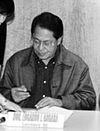Philippine Senate election, 1995
|
|
|||||||||||||||||||||||||||||||||||||||||||||||||||||
|---|---|---|---|---|---|---|---|---|---|---|---|---|---|---|---|---|---|---|---|---|---|---|---|---|---|---|---|---|---|---|---|---|---|---|---|---|---|---|---|---|---|---|---|---|---|---|---|---|---|---|---|---|---|
|
|||||||||||||||||||||||||||||||||||||||||||||||||||||
|
12 (of the 24) seats in the Senate 13 seats needed for a majority |
|||||||||||||||||||||||||||||||||||||||||||||||||||||
|
|||||||||||||||||||||||||||||||||||||||||||||||||||||
|
|||||||||||||||||||||||||||||||||||||||||||||||||||||
The senatorial election was held in the Philippines on May 8, 1995. Filipinos protected the ballot boxes with their lives and campaigned against traditional politicians who used bribery, flying voters, violence, election rigging, stealing of ballot boxes, etc. The Philippine National Police (PNP) had listed five dead and listed more than 200 hotspots before the election and during the election day listed 300 hotspots.
The two largest parties, the Lakas-NUCD and the Laban ng Demokratikong Pilipino (LDP) contested the senate election under the Lakas-Laban Coalition and won 9 of the 12 seats contested. The opposition-led coalition was composed of the Nationalist People's Coalition (NPC) which had an alliance with the People's Reform Party (PRP) although they contested election separately.
This was also the first time the electorate voted for twelve candidates under the plurality-at-large voting to the senate; previously the electorate voted for two candidates each per senatorial districts (1916–34), via closed party-lists (the "block voting" system in use from to 1941-49), and eight senators in the plurality-at-large voting with the country as one "at-large" district from 1951 to 1971. This was also the first midterm election as the date the elected candidates take office falls at the midway point of President Fidel V. Ramos' six-year term.
...
Wikipedia



